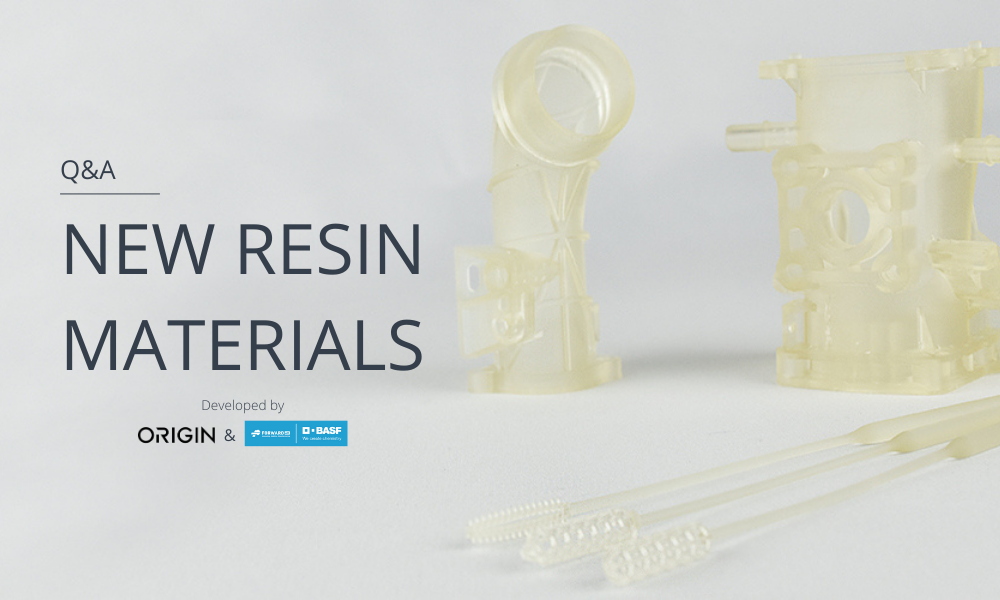ORIGIN resin materials: discover them with this Q&A.
Posted By Emma Moreau on Mar 17, 2021 | 0 comments
Forward AM partnered with ORIGIN to create new and innovative resin material for 3D printing. You will now be able to enjoy 3 new resin materials: Ultracur3D® ST 45, Ultracur3D® ST 45B, and Ultracur3D® RG 35. Alexandre D’Orsetti, Head of Sculpteo Studio, will answer this Q&A as a 3D Printing expert. Learn more about the ORIGIN technology and these next resin material in this Q&A.
1. What is ORIGIN Technology?
Origin is pioneering a new approach to additive manufacturing of end-use parts. With Origin One, their manufacturing-grade 3D printer, they use Programmable PhotoPolymerization to control light, heat, and force, among other variables, to produce accurate and consistent parts. Moreover, they develop their materials with many different partners allowing them to provide though and resilient materials for various industries and applications. Learn more about this technology on origin.io
2. How does it differ from other resin printing technologies?
Programmable PhotoPolymerization is really what differentiates Origin from other 3D printing technologies. When working with different factors such as light, heat, or force, Origin One can monitor the print in real-time and automatically optimizes prints to obtain the best results possible.
3. For what type of parts is it optimal to print with ORIGIN?
Rather small parts, with a high level of detail, or integrated functions such as intricate channels or complex geometries, for example, are really optimal for this technology. The speed of the machine makes it adapted for production parts.
4. What should be considered when printing with ORIGIN in terms of design?
As mentioned just above, the speed and precision of the technology make it really suitable for production. Thereby, it’s really interesting to design the parts for additive manufacturing and especially resin technologies to benefit the most of what Origin can offer. In resin technologies in general, the main constraint to consider is the supports. They are indispensable for some geometries, but when you have the freedom to design or adapt the part in a self-supported shape, it will give a better surface aspect, reduce the post-processing time, and save material. Then, to take advantage of the technology, general DfAM solutions, like functional integration, part-count reduction, and lightweighting are to be taken into account.
5. What is the Digital Light Processing (DLP) printing technology?
DLP technology is a resin 3D printing technology; it uses a light source to cure the resin. The resin is contained within a vat, or tank, cured against a build platform, which slowly rises out of the tank as the part is formed, layer by layer. The digital light projector is the light source of a DLP 3D printer. The DMD (Digital Micromirror Device) is a component made of thousands of micromirrors. These micromirrors are used for navigating the light beam projected by the digital light projector.
6. Which ORIGIN materials are available at Sculpteo?
Ultracur3D® ST 45:
- What are the characteristics of this material?
Ultracur3D® ST 45 is a resin material offering strength, long-term toughness, and good impact resistance. This material delivers translucent parts ideal for diverse applications. The technology used to print this material is Digital Light Processing (DLP), a technology mainly used and adapted to mass-production.
More information on Ultracur3D® ST 45 properties and design guidelines.
- What are the applications and advantages of this material?
With a Charpy notched of 1.39 kJ/m2 and elongation at a break of 25%, you can use this material for your projects requiring impact resistance and toughness. This material is also bio-compatible, making it perfect for all kinds of medical applications. Please keep in mind that it can not be in contact with fluids. You can also use its transparency finish for 3D printing projects such as transparent storage or housing.
Ultracur3D® ST 45B:
- What are the characteristics of this material?
Ultracur3D® ST 45B is also a resin material offering strong, long-term toughness and impact resistance. Ultracur3D® ST 45 B parts are 3D printed in black using Digital Light Processing (DLP) technology, a 3D printing technique particularly adapted to mass-production.
More information on the Ultracur3D® ST 45B properties and design guidelines.
- What are the applications and advantages of this material?
Benefiting from high accuracy, you will be able to use Ultracur3D® ST 45B for many applications, even the ones requiring great details. Indeed, ST 45B is ideal for manufacturing complex parts, thanks to its good surface finish for your aesthetics parts. This material also benefits from high-performance characteristics such as a Charpy notched of 2.66 kJ/m2 and elongation at break of 21,4%, making it a great fit for all your 3D printing projects requiring impact resistance and strength.
Ultracur3D® RG 35:
- What are the characteristics of this material?
Ultracur3D® RG 35 is a medium viscosity and highly reactive urethane photopolymer developed by Forward AM. This material offers high stability and stiffness on top of good temperature stability and low water uptake. This makes Ultracur3D® RG 35 the perfect choice to 3D print rigid functional parts with good resolution.
Ultracur3D® RG 35 parts are 3D printed in translucent using Digital Light Processing (DLP) technology adapted to mass-production.
More information on the Ultracur3D® RG 35 properties and design guidelines.
- What are the applications and advantages of this material?
Ultracur3D® RG 35 keeps its mechanical properties even when exposed to UV light, making it a great choice for 3D printing projects such as storage or automotive housings, for instance. Moreover, with its low water uptake, this resin is adapted to manufacture functional parts where humidity and fluids are involved.


 Connect with Google
Connect with Google Connect with Facebook
Connect with Facebook